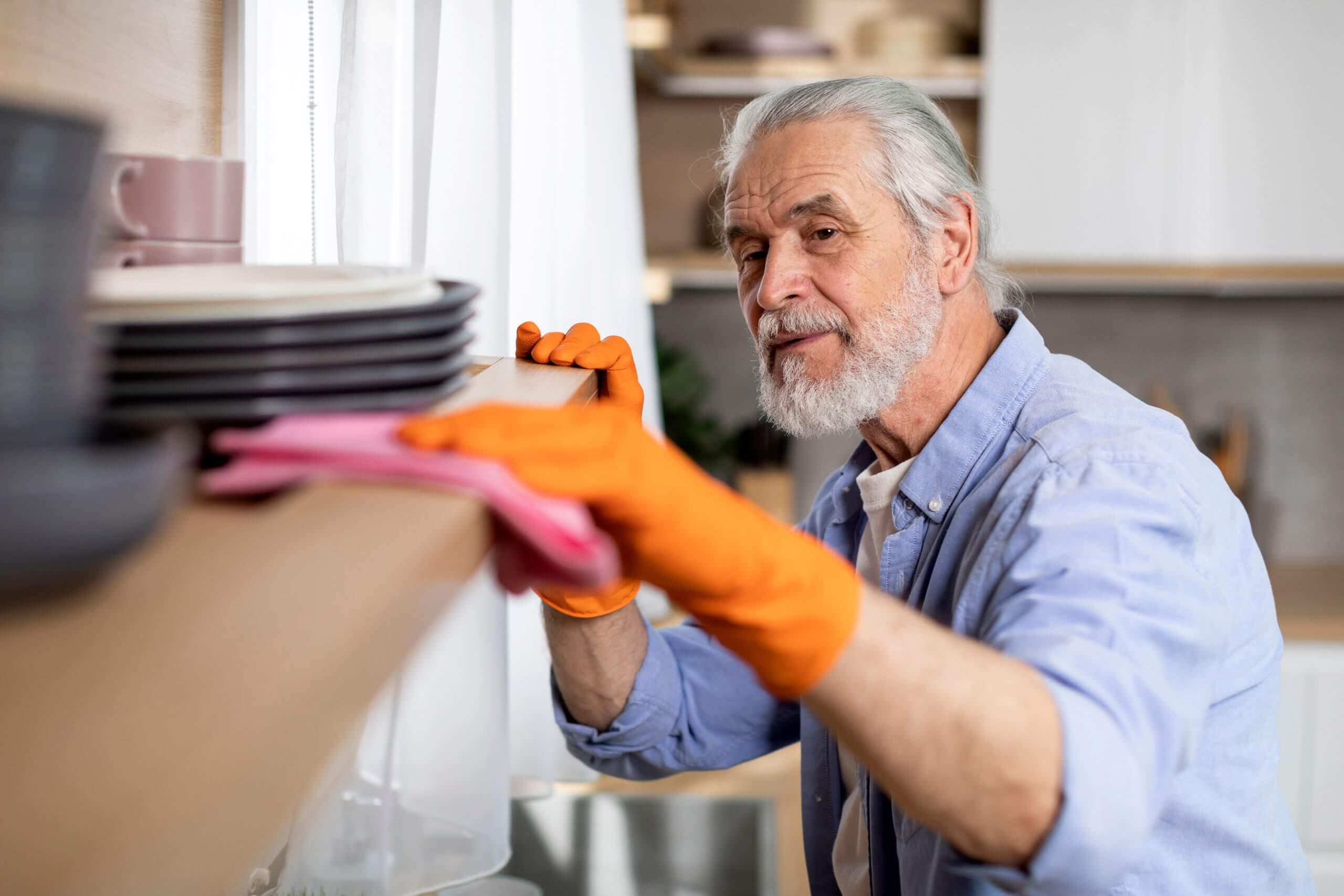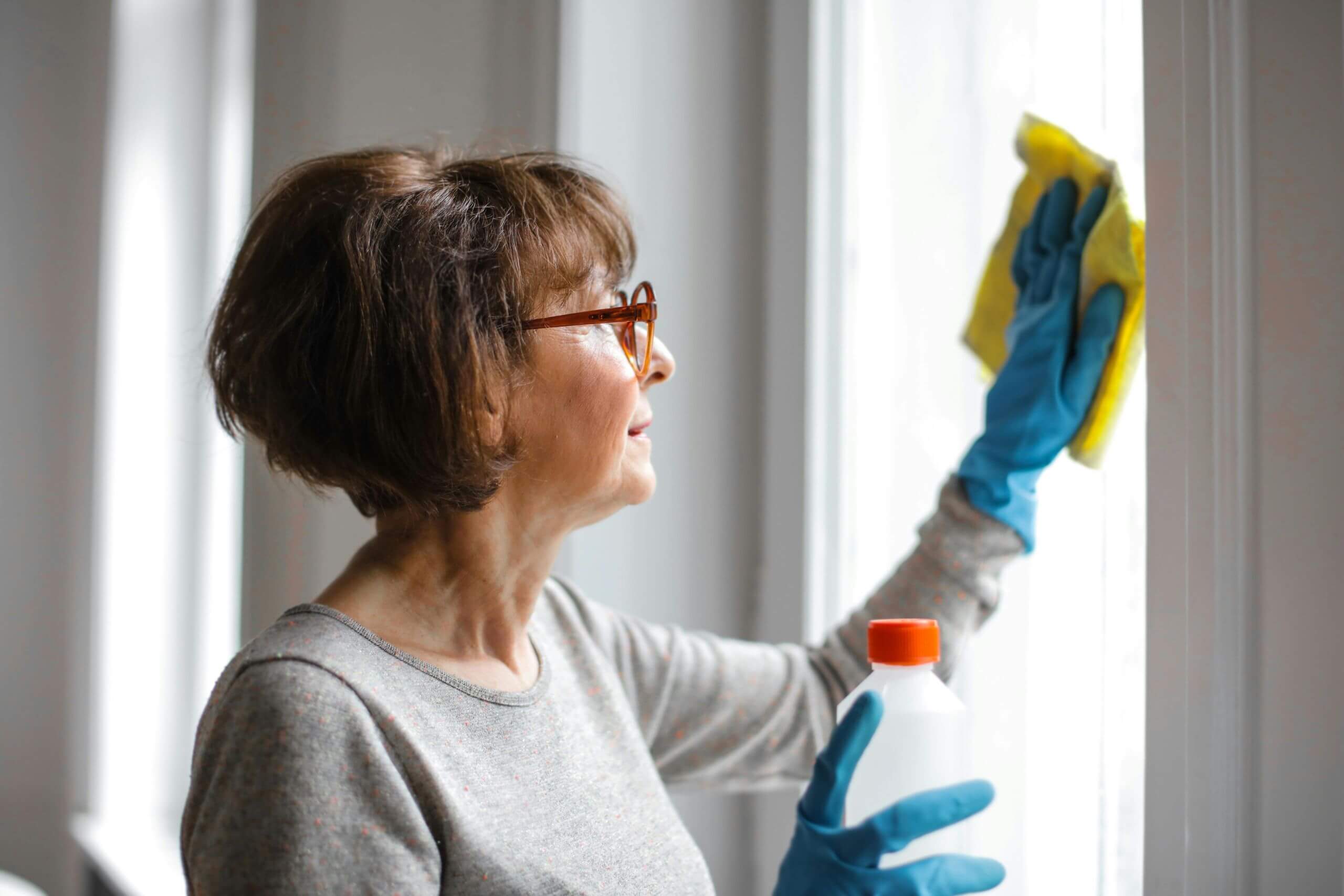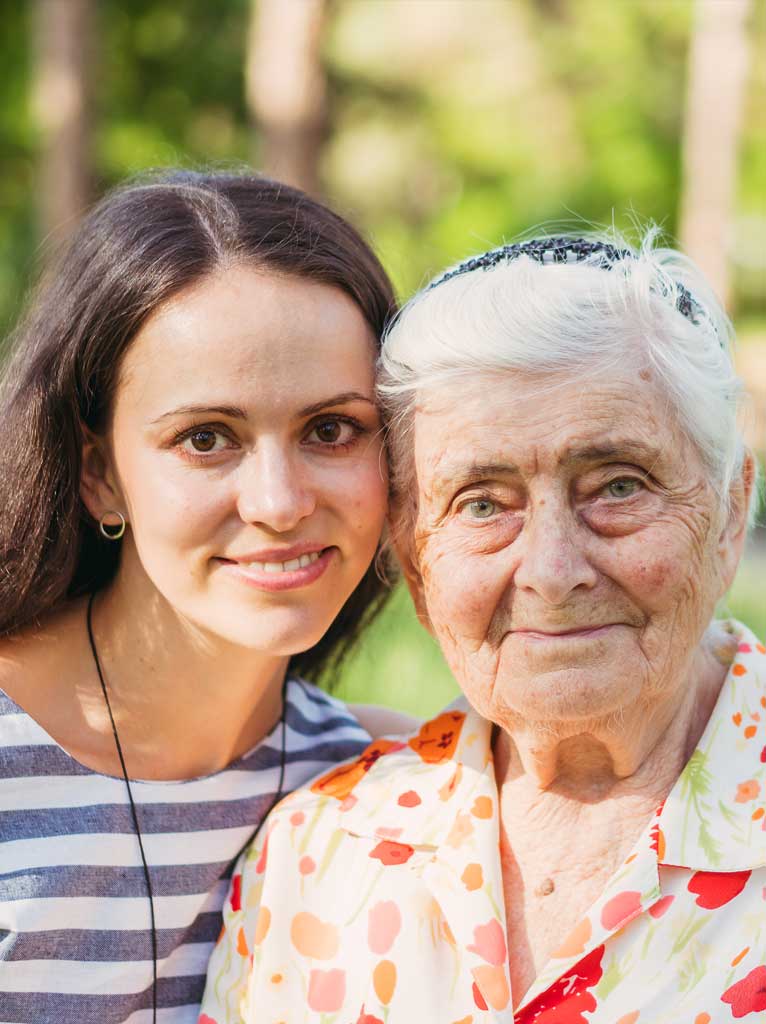Low-risk AT for housework
Welcome to our guide on low-risk assistive technology (AT) for jobs around the home. This page is part of our AT for everyday living series. It looks at simple, off-the-shelf items that can help older people do housework independently. It also shows how to use these items with other reablement ideas to promote healthy ageing.
Scroll down for more information.
Learn about low-risk assistive technology (AT) that can help older people maintain their home.
Using low-risk assistive devices for everyday tasks, such as housework, has many benefits.
For example, maintaining a home with the support of low-risk items can:
- Help improve important skills for daily living. This includes strength, balance, and hand control.
- Help people believe and take pride in themselves.
- Help reduce feelings of pain and fatigue.
Low-risk AT is a reablement strategy. It provides practical support for older people to do things for themselves.

This page will explore low-risk AT and other reablement strategies that older people can use to do household tasks. This includes:
- Building capacity
- Modifying the task
- Modifying the environment
- Providing information
If you don’t know what ‘low-risk’ means or are unfamiliar with these reablement strategies, don’t worry. We’ll explore these topics, too.
By the end, you’ll be able to talk to your client about AT and other reablement strategies. You’ll know how to help them consider items and lifestyle changes that can boost their independence.
Jump to a section of interest
What is low-risk assistive technology (AT)?
Complementary reablement strategies
Cleaning floors
Cleaning the bathroom
Cleaning surfaces
Other cleaning tasks
Useful resources
Next steps

What is low-risk assistive technology (AT)?
Low-risk AT is a reablement strategy. It means aids, equipment, or devices that can usually be bought ‘off the shelf’. These items also:
- Are not likely to cause harm
- Can be installed and used with minimal training or professional knowledge
Low-risk AT helps people be independent in daily tasks. These benefits are the focus of wellness and reablement.
Complementary reablement strategies
Building capacity focuses on enhancing the skills and abilities a person needs to perform daily tasks with greater confidence and independence.
Modifying the task involves adjusting how it is performed to make it easier, safer, or more effective for a person to complete.
Modifying the environment involves changing a person’s surroundings to make it easier for them to perform daily tasks.
Providing information involves offering relevant details and guidance about available services, resources, and support options that can enhance a person’s ability to care for themselves at home.
For example, you could encourage them to take LiveUp’s free healthy ageing quiz for personalised advice on how to live a full and independent life for longer.
Maximise the benefits of this AT with these considerations and reablement strategies:
Talk to your clients about why they’re having difficulty with vacuuming, sweeping, or mopping. This will help identify the best item to address their needs.
To gather this information, you could ask questions like:
· Why are they experiencing difficulties with this task?
· What type of equipment do they currently use and where is it stored?
· What is the environment like where the equipment is being used?
Consider consulting your clients’ coordinator about using assistive devices if their difficulties are related to a chronic health condition. For example, this could apply in cases where they have been noted as a fall risk or are experiencing severe pain or deformities from conditions like arthritis.Consider incorporating these reablement approaches to complement the use of AT and enhance your clients’ abilities:
· Consider your clients’ potential. Ask yourself, ‘Can this person improve their hand strength, coordination, mobility, or pain so they may not need this equipment in the future?’ Reflecting on this question can help you identify ways to increase their confidence, autonomy, and reduce their dependence on others over the long term.
· Encourage your clients to engage in activities that they are still able to, as this can help maintain their skills and confidence while promoting overall resilience. This can include activities that support good balance and mobility, which are important for maintaining independence. Sit-to-stand exercises for improving balance and mobility can be found at LiveUp.To continue performing housework independently, your clients could benefit from the following changes to essential cleaning tasks:
· Consider planning cleaning tasks such as spreading them out over a few hours or days to avoid fatigue or pain. Alternate between heavier and lighter tasks as needed, and be sure to incorporate breaks.
· Consider cleaning one room at a time instead of the entire house, and clean spills as they happen to prevent mess from spreading.
· Maintain a straight back while performing these tasks to avoid unnecessary slouching and straining. When using any cleaning equipment, walk slowly and organise tasks in a way that minimises unnecessary trips across the space.To continue performing housework independently, your clients could benefit from the following changes to their environment:
· Store frequently used equipment in easily accessible areas close to where they will be used. This will reduce the need to carry them over long distances.
· Remove rugs or damaged floor covers that could increase the risk of slips, trips, or falls, especially when using cleaning equipment.
· Make sure that the house is well lit, as this will make it easier to see and focus on areas that need to be cleaned.
· Make sure that no power cords are lying across the floor, as they can create a trip hazard; for example, by routing them along walls or under furniture using cord clips.If your clients are having difficulty due to chronic pain or an underlying health condition, advise their coordinator. They may benefit from a referral to a support organisation, such as Arthritis Australia, or to an allied health professional.
Maximise the benefits of this AT with these considerations and reablement strategies:
Talk to your clients about why they’re having difficulty cleaning areas of the bathroom, such as the shower, tiles, vanity, and toilet. This will help identify the right item to support their concerns.
To gather this information, you could ask questions like:
· Why are they experiencing difficulties with this task?
· What type of equipment do they currently use and where is it stored?
· What is the environment like where the equipment is being used?
Consider consulting your clients’ coordinator about using assistive devices if their difficulties are related to a chronic health condition. For example, this could apply in cases where they have been noted as a fall risk or are experiencing severe pain or deformities from conditions like arthritis.Consider incorporating these reablement approaches to complement the use of AT and enhance your clients’ abilities:
· Consider your clients’ potential. Ask yourself, ‘Can this person improve their hand strength, coordination, mobility, or pain so they may not need this equipment in the future?’ Reflecting on this question can help you identify ways to increase their confidence, autonomy, and reduce their dependence on others over the long term.
· Encourage your clients to engage in activities that they are still able to, as this can help maintain their skills and confidence while promoting overall resilience. This can include activities that prevent falls, which are important for maintaining confidence. Exercises for preventing falls can be found at LiveUp.To continue cleaning the bathroom independently, your clients could benefit from the following changes to essential cleaning tasks:
· Consider planning cleaning tasks such as spreading them out over a few hours or days to avoid fatigue or pain. Alternate between heavier and lighter tasks as needed, and be sure to incorporate breaks.
· Try wiping down surfaces like the shower screen a few times a week after showering to prevent soap scum buildup. Using spray-on, no-scrub cleaners can help lift soap scum and other grime with less effort. A little regular maintenance goes a long way and makes weekly cleaning easier.
· Make sure that the bathroom has adequate lighting and ventilation, particularly when using cleaning products or when steam is present. Good lighting helps identify areas that need to be cleaned. Proper ventilation reduces the buildup of fumes from cleaning products and helps prevent mould growth from excess steam.To continue cleaning the bathroom independently, your clients could benefit from the following changes to their environment:
· Make sure that the bathroom is well lit, as this will make it easier to see and focus on areas that need to be cleaned.
· Make sure that exhaust fans are working properly and used whenever hot water is running, as this helps remove steam from the air and surfaces. Proper ventilation, whether through an open window or an exhaust fan, prevents mould growth and reduces the risk of slips.If your clients are having difficulty due to chronic pain or an underlying health condition, advise their coordinator. They may benefit from a referral to a support organisation, such as Arthritis Australia, or to an allied health professional.
Maximise the benefits of this AT with these considerations and reablement strategies:
Talk to your clients about why they are having difficulty wiping surfaces in their home. This will help find the right item to support their concerns.
To gather this information, you could ask questions like:
· Why are they experiencing difficulties with this task?
· What type of equipment do they currently use and where is it stored?
· What is the environment like where the equipment is being used?
Consider consulting your clients’ coordinator about using assistive devices if their difficulties are related to a chronic health condition. For example, this could apply in cases where they have been noted as a fall risk or are experiencing severe pain or deformities from conditions like arthritis.Consider incorporating these reablement approaches to complement the use of AT and enhance your clients’ abilities:
· Consider your clients’ potential. Ask yourself, ‘Can this person improve their hand strength, coordination, mobility, or pain so they may not need this equipment in the future?’ Reflecting on this question can help you identify ways to increase their confidence, autonomy, and reduce their dependence on others over the long term.
· Encourage your clients to engage in activities that they are still able to, as this can help maintain their skills and confidence while promoting overall resilience. This can include low-risk exercise that supports good brain and body health, which are fundamental to healthy ageing. Low-risk exercise recommendations for older people can be found at LiveUp.To continue cleaning surfaces independently, your clients could benefit from the following changes to essential cleaning tasks:
· Consider planning cleaning tasks such as spreading them out over a few hours or days to avoid fatigue or pain. Alternate between heavier and lighter tasks as needed, and be sure to incorporate breaks.
· Consider storing cleaning items in a central location or placing dusting cloths in each room when possible. This will help minimise the need for frequent trips across large spaces and the risk of fatigue.
· Maintain a straight back while performing these tasks to avoid unnecessary slouching and straining.
· Use damp dusting cloths instead of dry ones to trap and remove dust particles more effectively.To continue cleaning surfaces independently, your clients could benefit from the following changes to their environment:
· Remove rugs or damaged floor covers that could increase the risk of slips, trips, or falls, especially when using cleaning equipment.
· Make sure that the house is well lit, as this will make it easier to see and focus on areas that need to be cleaned.
· Make sure that no power cords are lying across the floor, as they can create a trip hazard; for example, by routing them along walls or under furniture using cord clips.If your clients are having difficulty due to chronic pain or an underlying health condition, advise their coordinator. They may benefit from a referral to a support organisation, such as Arthritis Australia, or to an allied health professional.
Maximise the benefits of this AT with these considerations and reablement strategies:
Talk to your clients about why they are having difficulty with cleaning tasks around the home. This will help find the right item to support their concerns.
To gather this information, you could ask questions like:
· Why are they experiencing difficulties with this task?
· What type of equipment do they currently use and where is it stored?
· What is the environment like where the equipment is being used?
Consider consulting your clients’ coordinator about using assistive devices if their difficulties are related to a chronic health condition. For example, this could apply in cases where they have been noted as a fall risk or are experiencing severe pain or deformities from conditions like arthritis.Consider incorporating these reablement approaches to complement the use of AT and enhance your clients’ abilities:
· Consider your clients’ potential. Ask yourself, ‘Can this person improve their hand strength, coordination, mobility, or pain so they may not need this equipment in the future?’ Reflecting on this question can help you identify ways to increase their confidence, autonomy, and reduce their dependence on others over the long term.
· Encourage your clients to engage in activities that they are still able to, as this can help maintain their skills and confidence while promoting overall resilience. This can include activities that support strong, flexible hands, which are important for maintaining independence. Tips for keeping hands healthy can be found at LiveUp.To continue maintaining their home independently, your clients could benefit from the following changes to essential cleaning tasks:
· Consider planning cleaning tasks such as spreading them out over a few hours or days to avoid fatigue or pain. Alternate between heavier and lighter tasks as needed, and be sure to incorporate breaks.
· Store frequently used equipment in easily accessible areas close to where it will be used. This will reduce the need to carry it over long distances. Also, make sure that the house has adequate lighting and is free from trip hazards, such as cords or damaged flooring.
· Maintain a straight back while performing these tasks to avoid unnecessary slouching and straining.
· Use cleaning hacks to reduce the amount of time and effort needed to maintain a home. For example, an easy way to clean the microwave is by placing a cup one-third full of lemon juice in the microwave and heating it until boiling. The steam will loosen debris and grease, making it easier to wipe away.To continue maintaining their home independently, your clients could benefit from the following changes to their environment:
· Remove rugs or damaged floor covers that could increase the risk of slips, trips, or falls, especially when using cleaning equipment. Good lighting will also reduce the risk of falling.
· It’s preferred to perform cleaning tasks during the day, as natural light makes it easier to spot dirt and debris without causing eye strain.
· Make sure that your clients are completing cleaning tasks at the best time of day for them. This can depend on their vision, energy levels, and other activities or priorities. This will help reduce feelings of tiredness and frustration.Consider consulting your clients’ coordinator about using assistive devices if their difficulties are related to a chronic health condition. For example, this could apply in cases where they have been noted as a fall risk or are experiencing severe pain or deformities from conditions like arthritis.
Useful resources
Reablement Essentials are practical guides researched and curated by our Sector Support and Development team. These guides can help you better understand key wellness and reablement concepts, communicate their value to your clients, and ultimately support your clients to pursue healthier and more independent lives.
Next steps
The low-risk assistive (AT) and other reablement strategies explored on this page can support your clients in managing their household tasks independently.
And by supporting your clients to do things for themselves, these strategies can enhance their sense of confidence, autonomy, and potential to age well.
If you want to learn more about integrating assistive devices into your care planning, please email us at keepable@ilaustralia.org.au or submit the ‘Connect with Keep Able‘ form below.
We also provide tailored presentations on wellness and reablement for teams wanting to enhance their knowledge and skills, just ask us about it via email or complete the contact form below!
Thank you for your commitment to wellness and reablement. By supporting your clients to do things for themselves, you support them to age on their own terms, in their own homes, longer.
DISCLAIMER: Please note that while brand names may appear on this page, their inclusion does not imply our endorsement. These branded images have been sourced from our affiliated organisations, LiveUp and NED (National Equipment Database), and Pinterest to provide informational support and inspiration, not to promote any specific products
Sign up here to join the Count Me In community. By signing up, you’ll receive monthly updates about our latest resources and other exciting developments in wellness and reablement. While signing up, feel free to provide feedback, ask a question, or request a free professional development presentation.
Disclaimer: By submitting this form, you are agreeing to be added to the Count Me In hub, and receive our monthly newsletter. We might also ask for your input and feedback on aged care-related topics, and on new KeepAble resources. You can unsubscribe from this list at any time, and your details will be held by KeepAble only.


























